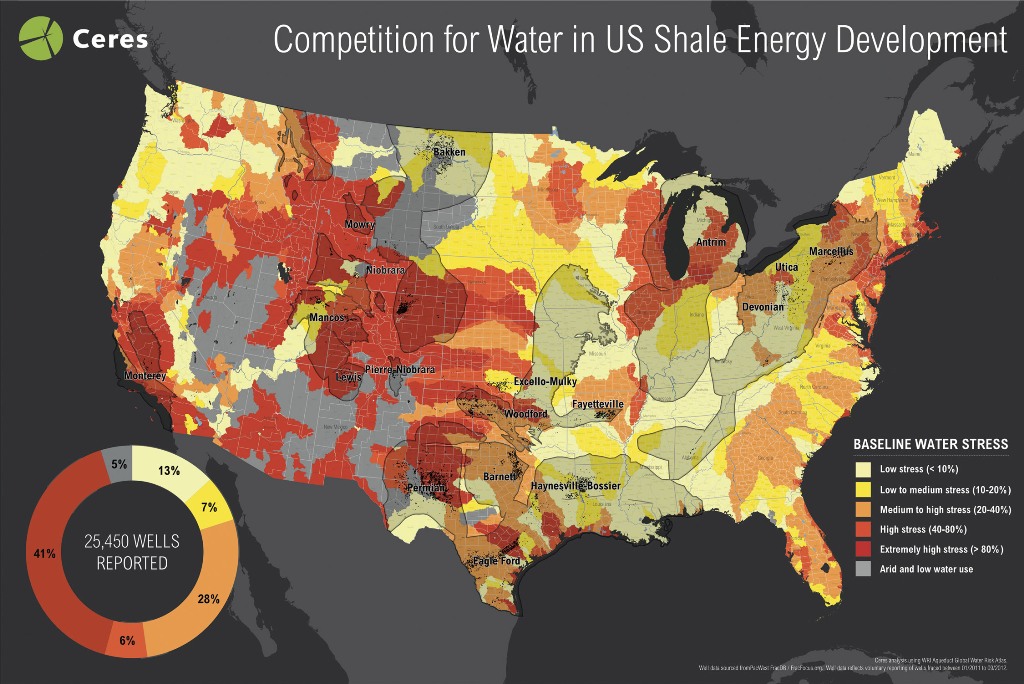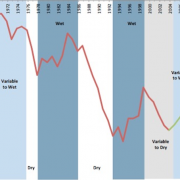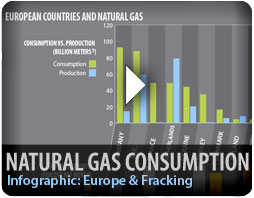Report: Half of U.S. Fracking Wells Drilled in Highly Water-stressed Regions
Energy companies should provide better data on fracking water use, and investors should push for quantifiable water targets, according to a sustainable investing advocacy group.

By Brett Walton
Circle of Blue
Not even six years old, the energy boom in the United States has roiled rural towns and revived the country’s economic prospects. It has also shaken up long-established patterns of resource use, chiefly for water, thus adding a new source of demand in some of the country’s driest regions.
A report released last week maps the relationship between water stress and the unconventional oil and gas reserves that have pushed the boom, while outlining actions energy companies can take to improve resource management.
Nearly half of the wells drilled in the U.S. in recent years, 47 percent, are located in river basins with high or extremely high risk of water stress, according to the report from Ceres, a nonprofit that works with investors, businesses and credit rating agencies to identify environmental risks in business models.
Drilling rigs, America’s newest crop, have sprouted above shale formations across the country. They drill deep wells with horizontal shafts and then shoot jets of water, sand, and chemicals underground to crack open the stores of oil and gas trapped thousands of feet below. Called hydraulic fracturing, or fracking, this technique, along with horizontal drilling, has put the U.S. on a path toward being a net exporter of natural gas and the world’s top oil producer, briefly, by the end of the decade.
The path, however, has hazards. Water risks, the Ceres report found, are particularly acute in Colorado, where 92 percent of wells have been drilled in areas of extremely high water stress.
In terms of quantity, Texas used the most water for fracking, more than three times as much as Pennsylvania, the second largest user.
As domestic energy development has mushroomed, water concerns have shifted from quality to quantity, said Monika Freyman, the report’s lead author.
“Investors at first were interested in water contamination and a lack of disclosure about the chemicals used, which might have affected a company’s social license to operate,” Freyman told Circle of Blue. “As the drought continues, more investors are asking how companies can increase the number of wells in arid areas.”
“This is not just about sustainability,” said Paul Bugala, an extractive industries analyst for Calvert Investments. “It’s about project viability.”
Mapping the Problem
To understand fracking’s relationship with water stress, Freyman and co-author Ryan Salmon looked at two data sets. They gathered information on well location and water volumes used in fracking from the website FracFocus.org, a data clearinghouse run by the Groundwater Protection Council and the Interstate Oil and Gas Compact Commission.
Ceres plotted more than 25,000 shale gas and shale oil wells – nearly half of which were in Texas – that were registered with FracFocus between January 2011 and September 2012. Water used to frack these wells amounted to 246 million cubic meters (200,000 acre-feet), or enough water for the domestic needs of a city of 2.5 million people using 266 liters (70 gallons) per day. Because data submitted to the clearinghouse is voluntary, the reported figures are not comprehensive. Water sources, be they salty, fresh or recycled, are not disclosed either.
The FracFocus data was then laid on top of the water-risk maps developed by the World Resources Institute. A basin with “extremely high” water stress means that more than 80 percent of the available water is already claimed by cities, farmers, or industry.
Lifting the Data Curtain
For Ceres, open data is paramount for better resource and business management.
“Disclosure is the foundation,” said Mindy Lubber, Ceres president, at the organization’s annual conference in San Francisco on May 2. “You cannot connect the dots without this vital piece – information.”
Michael Webber, who studies the connections between water use and energy development at the University of Texas, preached the same message in testimony before a U.S. Senate committee a week earlier. FracFocus, though voluntary and imperfect, is the foremost central database for fracking’s water use. Webber told the committee members that the federal government, either the Energy Information Administration or the U.S. Geological Survey, should track this information.
–Mindy Lubber, Ceres president
Disclosure is welcomed, but regulators should use this information to create standards that are regionally specific, says Andrew Place.
Place works on energy and environmental policy for EQT, an energy company producing in Pennsylvania’s Marcellus shale formation, and he is the interim director of the Center for Sustainable Shale Development, a collaboration between industry and environmental groups that laid out voluntary performance standards in March for shale drilling in the Appalachian region.
Because the volume of water in rivers changes throughout the year, withdrawals during low flows might cause greater harm than during peak flows, Place said.
And certain locations see more demand from energy companies. In Johnson County, Texas, some 29 percent of water use in 2008 was for fracking. In the Eagle Ford shale formation in southern Texas, a young shale play, fracking, at its crest year, will account for between 5.2 percent and 89 percent of water use in six counties in the next decade, according to a University of Texas study.
So the challenge is to identify “a water risk for a specific time and place,” Place told Circle of Blue.
Money Talks
Investors – at least the group of 100 allied with the Ceres philosophy – crave better information. Paul Bugala of Calvert Investments, a member of the Ceres investor network, said that Calvert wants to see baseline information on water quality and water quantity before a fracking operation begins.
In April, Calvert filed a resolution with Pioneer Natural Resources, an energy company drilling mainly in Texas, through the U.S. Securities and Exchange Commission to encourage better disclosure of environmental risks, including water use. Calvert holds shares in Pioneer.
“Sometimes it takes investor pressure to get through to company management, so it is important for investors to speak up,” Bugala told Circle of Blue.
Southeastern Asset Management, which is not in the Ceres investor network and is one of the largest shareholders in Chesapeake Energy, a top producer of natural gas in the U.S., declined to comment on the report.
–Paul Bugala, Calvert Investments
Some industry groups do not see a problem with fracking’s water use. When asked via email if he thought the current regulatory, water-use reporting, and water acquisition structures in his state were adequate, Doug Flanders, spokesman for the Colorado Oil and Gas Association, wrote simply, “Yes.”
Flanders pointed out that Colorado – a high water-risk state according to the Ceres report – requires oil and gas companies to submit a detailed water-use report and that all water must be obtained by purchasing or leasing existing water rights, municipal effluent, or groundwater.
The water risk report is one piece of a broader Ceres project on fracking. Freyman said that later this summer the organization will release a report that compares water disclosure policies for companies involved in fracking and outlines the states where new fracking regulations are expected.
The goal of all this is to find how water fits in America’s new energy economy.
“Industry is able to outbid farmers for water, which is fine,” Freyman said. “But there is a need for management with local interests. We need a conversation about how society values water – the costs and the benefits and how to sell it and allocate it.”
Brett writes about agriculture, energy, infrastructure, and the politics and economics of water in the United States. He also writes the Federal Water Tap, Circle of Blue’s weekly digest of U.S. government water news. He is the winner of two Society of Environmental Journalists reporting awards, one of the top honors in American environmental journalism: first place for explanatory reporting for a series on septic system pollution in the United States(2016) and third place for beat reporting in a small market (2014). He received the Sierra Club’s Distinguished Service Award in 2018. Brett lives in Seattle, where he hikes the mountains and bakes pies. Contact Brett Walton











Part of what the moribund U.S. environmental movement needs — and in particular the fractured and chronically outclassed anti-fracking movement — is an angrier soundtrack, not bogged down with musical baggage from old, hippy-dippy environmental campaigns. Here’s a new American anthem guaranteed to stir the soul of any red-blooded environmentalist, as well as lure a few emotionally sensitive people over from the dark side. Feel free to use it. Scream your anger!
http://biffthuringer.bandcamp.com/track/to-america
There is a highly successful alternative to water fracing and it has been performed since 2009 with over 2000 fracs so far by a company named GASFRAC. they are a publicly traded company that has not received the recognition they deserve and I can see why if you do not know about. I feel the tide is slowly turning in the industry though and more education is all it needs. It is a viably alternative to water fracing and it will come about I am sure since this country or it,s people can’t survive without water or survive without the gas and oil that can be brought out of the ground with this method.